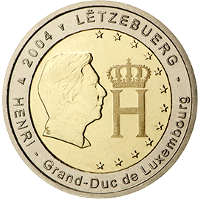 |
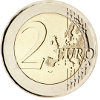 |
C o m m e m o r a t i v e
C o i n s |
||
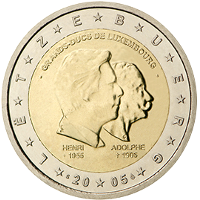 🔎
🔎 |
 |
Luxembourg | 15 Feb. 2005 | 50th birthday of Grand Duke Henri, 5th anniversary of his accession to the throne
and 100th anniversary of the death of Grand Duke Adolphe 2nd coin of the Grand-Ducal Dynasty series |
20001 20002 20005 |
2,769,000 |  |
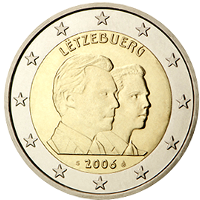 🔎
🔎 |
 |
Luxembourg | 01 Feb. 2006 | 25th birthday of Hereditary Grand Duke Guillaume 3rd coin of the Grand-Ducal Dynasty series |
20001 20002 20005 |
1,047,500 |  |
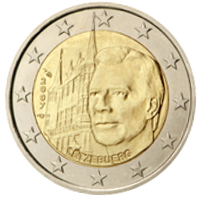 🔎
🔎 |
 |
Luxembourg | 02 Feb. 2007 | Grand Ducal Palace 4th coin of the Grand-Ducal Dynasty series |
20001 20002 20005 |
1,031,000 |  |
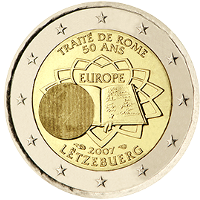 🔎
🔎 |
 |
Luxembourg | 26 Mar. 2007 | 50th anniversary of the Signature of the Treaty of Rome |
20001 20002 20005 |
2.046.000 |  |
National characteristics : At the top are the words "TRAITÉ DE ROME" (Treaty of Rome) and "50 ANS" (50 years), below it is an illustration of the treaty with the words "EUROPE", below that is the year "2007" flanked on the left by a cornucopia the mint mark of the French mint Monnaie de Paris in Plessac and on the right by a hunting horn with the sign of the zodiac Pisces the logo of mint master Hubert Larivière and the country name "LËTZEBUERG" (Luxembourg). The Luxembourg coins also have a latent image of Grand Duke Henri imprinted on the left side of the document, as according to Luxembourg law no national coin may be issued without the face of the head of state (or at least not without his monogram). |
|||||||
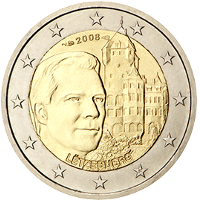 🔎
🔎 |
 |
Luxembourg | 01 Feb. 2008 | Berg Castle 5th coin of the Grand-Ducal Dynasty series |
20001 20002 20005 |
1,042,000 |  |
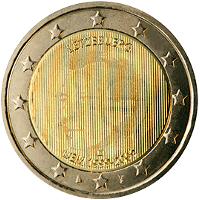 🔎
🔎 |
 |
Luxembourg | 15 Jan. 2009 | 10 years of Economic and Monetary Union (EMU) |
20001 20002 20005 |
825.000 |  |
National characteristics : Above is the name of the issuing country "LËTZEBUERG" (Luxembourg), the acronym of the occasion of issue below is "UEM". Above the number "1999" is a square around the designer's "ΓΣ" deviating from the usual place due to multi-view minting. The logo of mint master Maarten Brouwer, the sails of the three‐masted clipper Nederland, flanks the 6 o'clock star on the left and the staff of Hermes the mint mark of the Dutch mint Koninklijke Nederlandse Munt in Utrecht on the right. Above the motif is the portrait of Grand Duke Henri designed by Alain Hoffmann as a latent image, since according to Luxembourg law no national coin may be issued without the portrait of the head of state (or at least his monogram). |
|||||||
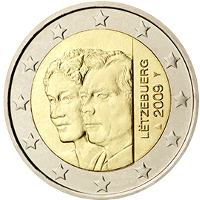 🔎
🔎 |
 |
Luxembourg | 15 Jan. 2009 | 90th anniversary of Grand Duchess Charlotte's Accession to the Throne 6th coin of the Grand-Ducal Dynasty series |
20001 20002 20005 |
838,000 |  |
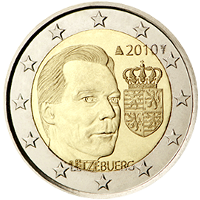 🔎
🔎 |
 |
Luxembourg | 14 Jan. 2010 | Coat of Arms of Grand Duke Henri 7th coin of the Grand-Ducal Dynasty series |
20001 20002 20005 |
529,500 |  |
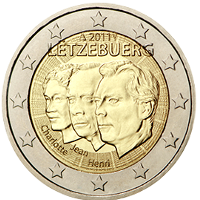 🔎
🔎 |
 |
Luxembourg | 03 Feb. 2011 | 50th anniversary of the Appointment of Jean by his mother
Charlotte, Grand Duchess of Luxembourg as lieutenant-représentant 8th coin of the Grand-Ducal Dynasty series |
20001 20002 20005 |
729,500 |  |
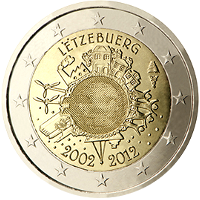 🔎
🔎 |
 |
Luxembourg | 30 Jan. 2012 | 10 years Euro‐Currency |
20001 20002 20005 |
532.500 |  |
National characteristics : At the top of the coin is the name of the issuing country "LËTZEBUERG" (Luxembourg). The logo of mint master Maarten Brouwer, the sails of the three‐masted clipper Nederland, and a staff of Hermes the mint mark of the Dutch mint Koninklijke Nederlandse Munt in Utrecht are depicted on the right between the symbols of homes and family. Above the € symbol in the centre is the portrait of Grand Duke Henri designed by Alain Hoffmann as a latent image, since according to Luxembourg law no national coin may be issued without the portrait of the head of state (or at least not without his monogram). |
|||||||
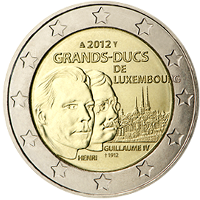 🔎
🔎 |
 |
Luxembourg | 30 Jan. 2012 | 100 years since the death of William IV, Grand Duke of Luxembourg 9th coin of the Grand-Ducal Dynasty series |
20001 20002 20005 |
722,500 |  |
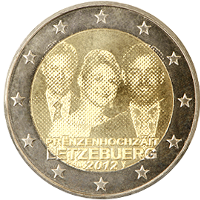 🔎
🔎 |
 |
Luxembourg | 20 Dec. 2012 | Royal Wedding of Guillaume, Hereditary Grand Duke of Luxembourg to Countess Stéphanie de Lannoy 10th coin of the Grand-Ducal Dynasty series |
20001 20002 20005 |
512,000 |  |
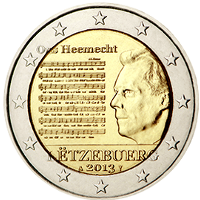 🔎
🔎 |
 |
Luxembourg | 16 Oct. 2013 | National Anthem of the Grand Duchy 11th coin of the Grand-Ducal Dynasty series |
20001 20002 20005 |
522,000 |  |
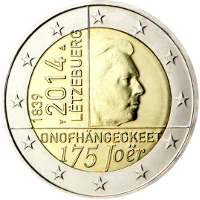 🔎
🔎 |
 |
Luxembourg | 06 Jan. 2014 | 175th anniversary of the independence of the Grand‐Duchy of Luxembourg 12th coin of the Grand-Ducal Dynasty series |
20001 20002 20005 |
519,500 |  |
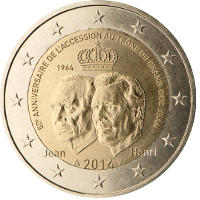 🔎
🔎 |
 |
Luxembourg | 06 Nov. 2014 | 50th anniversary of Grand Duke Jean's accession to the throne 13th coin of the Grand-Ducal Dynasty series |
20001 20002 20005 |
512,000 |  |
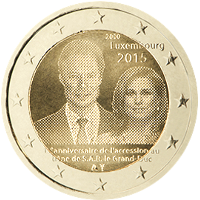 🔎
🔎 |
 |
Luxembourg | 08 Jun. 2015 | 15th anniversary of Grand Duke Henri Accession to the Throne 14th coin of the Grand-Ducal Dynasty series |
20001 20002 20005 |
517,500 |  |
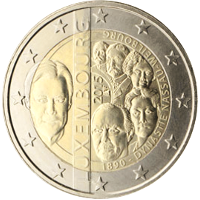 🔎
🔎 |
 |
Luxembourg | 15 Oct. 2015 | 125th anniversary of the Nassau-Weilburg Dynasty 15th coin of the Grand-Ducal Dynasty series |
20001 20002 20005 |
511,500 |  |
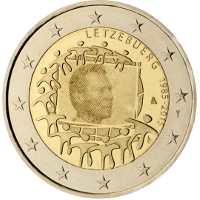 🔎
🔎 |
 |
Luxembourg | 03 Dec. 2015 | 30 years EU‐Flag |
20001 20002 20005 |
510.000 |  |
National characteristics : Above is the name of the issuing country "LËTZEBUERG" (Luxembourg) followed by the dates "1985‐2015". On the right, the sails of the three‐masted clipper Nederland are depicted the logo of the mint master Maarten Brouwer. The coin was produced without mint mark by the Dutch mint Koninklijke Nederlandske Munt in Utrecht. A latent image of Grand Duke Henri is also displayed, as according to Luxembourg law no national coin may be issued without the image of the head of state (or at least not without his monogram). |
|||||||
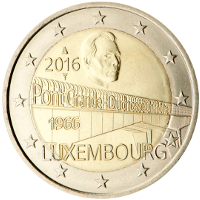 🔎
🔎 |
 |
Luxembourg | 06 May 2016 | The 50th anniversary of the "Grand Duchess Charlotte Bridge" 16th coin of the Grand-Ducal Dynasty series |
20001 20002 20005 |
517,500 |  |
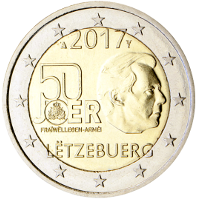 🔎
🔎 |
 |
Luxembourg | 02 Jan. 2017 | The 50th anniversary of the voluntariness of the Luxembourg army 17th coin of the Grand-Ducal Dynasty series |
20001 20002 20005 |
316,000 |  |
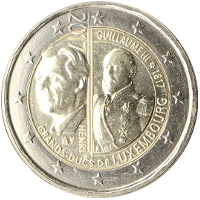 🔎
🔎 |
 |
Luxembourg | 26 Oct. 2017 | The 200th anniversary of the Grand Duke Guillaume III 18th coin of the Grand-Ducal Dynasty series |
20001 20002 20005 |
311,000 |  |
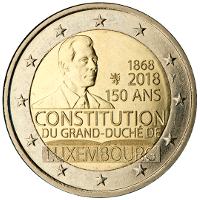 🔎
🔎 |
 |
Luxembourg | 19 Dec. 2017 | 150 years of the Luxembourg Costitution 19th coin of the Grand‐Ducal Dynasty series |
20001 20002 20005 |
319,100 |  |
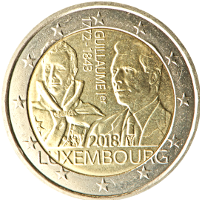 🔎
🔎 |
 |
Luxembourg | 27 Aug. 2018 | 175 years since the death of Grand Duke William I 20th coin of the Grand‐Ducal Dynasty series |
20001 20002 20005 |
311,000 |  |
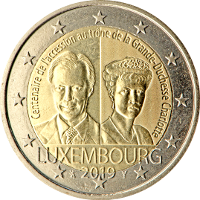 🔎
🔎 |
 |
Luxembourg | 27 Dec. 2018 | 100th anniversary of Grand Duchess Charlotte's accession to the throne 21st coin of the Grand‐Ducal Dynasty series |
20001 20002 20005 |
316,000 |  |
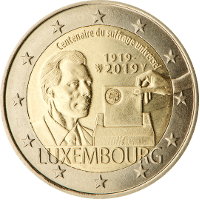 🔎
🔎 |
 |
Luxembourg | 19 Sep. 2019 | 100 years of universal suffrage in Luxembourg 22nd coin of the Grand‐Ducal Dynasty series |
20001 20002 20005 |
311,000 |  |
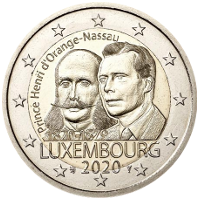 🔎
🔎 |
 |
Luxembourg | 26 Feb. 2020 | Bicentenary of the birth of Prince Henry of Orange-Nassau 23rd coin of the Grand‐Ducal Dynasty series |
20001 20002 20005 |
316,000 |  |
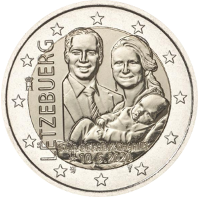 🔎
🔎
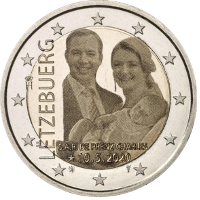 🔎
🔎 |
 |
Luxembourg | 24 Dec. 2020 | Birth of Prince Charles of Luxembourg 24th coin of the Grand‐Ducal Dynasty series |
20001 20002 20005 |
331,000 |  |
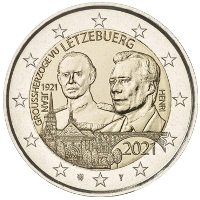 🔎
🔎
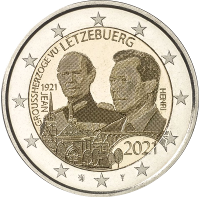 🔎
🔎 |
 |
Luxembourg | 19 Apr. 2021 | 100th birthday of Grand Duke Jean 25th coin in the Grand‐Ducal Dynasty series |
20001 20002 20005 |
333,500 |  |
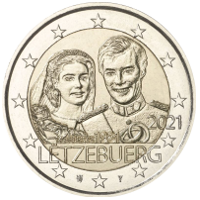 🔎
🔎
 🔎
🔎 |
 |
Luxembourg | 19 Apr. 2021 | 40th wedding anniversary of Grand Duke Henri and Grand Duchess Maria Teresa 26th coin in the Grand‐Ducal Dynasty series |
20002 20007 20008 |
333,500 |  |
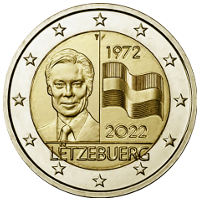 🔎
🔎 |
 |
Luxembourg | 01 Jul. 2022 | 50th anniverasy of the legal protection of the Flag of Luxembourg 27th coin in the Grand‐Ducal Dynasty series |
20003 20005 |
261,000 |  |
 Work in progress |
|||||||
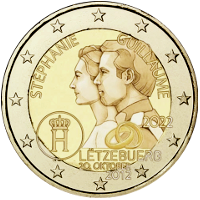 🔎
🔎 |
 |
Luxembourg | 01 Jul. 2022 | 10th wedding anniversary of Hereditary Grand Duke Guillaume and Hereditary Grand Duchess Stéphanie 28th coin in the Grand‐Ducal Dynasty series |
20003 20005 |
261,000 |  |
 Work in progress |
|||||||
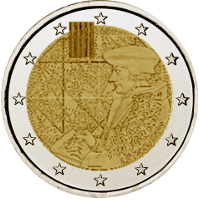 🔎
🔎 |
 |
Luxembourg | 01 Jul. 2022 | 35th anniversary of the Erasmus Program |
20003 20005 20009 |
258,500 |  |
National characteristics : The quarter circle at the bottom right has four lines; below the commemorative period, the issue occasion "ERASMUS PROGRAMME" is written in two lines, below which is the issuing country "LËTZEBUERG" (Luxembourg). At the top left is a latent image of the monogram of Grand Duke Henri, as Luxembourg law does not allow a national coin to be issued without the effigy of the head of state (or at least not without his monogram). On the standard coins, a staff of Hermes is depicted at the bottom on the left sleeve as the mint mark of the Royal Dutch mint Koninklijke Nederlandse Munt in Houten. On coins in the proof production process a cornucopia is depicted at the bottom on the left sleeve as the mint mark of the French mint Monnaie de Paris in Plessac on the left and the designer's signet next to it on the right. The coin is one of those with a more textured background. |
|||||||
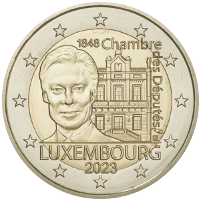 🔎
🔎
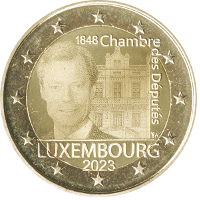 🔎
🔎 |
 |
Luxembourg | 24 Apr. 2023 | 175th anniversary of the Chamber of Deputies and of the First Constitution 29th coin in the Grand‐Ducal Dynasty series |
20003 20005 20009 |
133,500 |  |
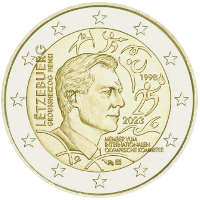 🔎
🔎
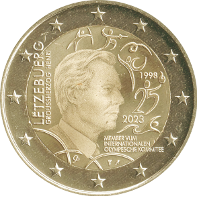 🔎
🔎 |
 |
Luxembourg | 24 Apr. 2023 | 25th anniversary of the admission of Grand Duke Henri as a member of the
International Olympic Committee 30th coin in the Grand‐Ducal Dynasty series |
20003 20005 20009 |
133,500 |  |
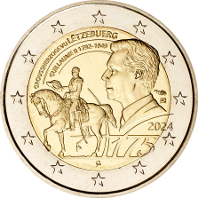

|
 |
Luxembourg | 29 Jan. 2024 | 175th anniversary of the death of Grand Duke Guillaume II 30th coin in the Grand‐Ducal Dynasty series |
20003 | 127,500 |  |
 Work in progress |
|||||||
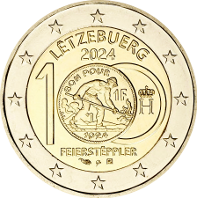

|
 |
Luxembourg | 29 Jan. 2024 | 100th anniversary of the introduction of the franc coins with the Feierstëppler | 20003 | 127,500 |  |
 Work in progress |
|||||||
| References : | |||
| 20001 | Images taken with authorisation by the ECB ‐ Mail dated 20.Feb.2020 © "European Central Bank" |
20002 | Data mirrored from Wikipedia Page "2_euro_commemorative_coins" with friendly support of the guardians of that page. |
| 20003 | Images taken with authorisation by H....... Hamburg | 20004 | Coloured version of this Commemorative Coin in circulation EU‐legal‐technical specifications do not recongnise colour prints, but the EU is tolerate them, due to the facts that their numbers are very small and that they are sold in special packs and therefor are very unlikely to be used as currency. |
| 20005 |
enlarged Images taken with authorisation by Gerd Seyffert © "Gerd Seyffert 2021" |
20006 | Not Applicable |
| 20007 | Images taken by Münzen Kreuzberg © "Münzen Kreuzberg 2021" |
20008 | enlarged Images taken by Münzen Kreuzberg © "Münzen Kreuzberg 2021" |
| 20009 | Text with kind permission by Gerd Seyffert © "Gerd Seyffert 2023" |
20010 | Not Applicable |
 |

